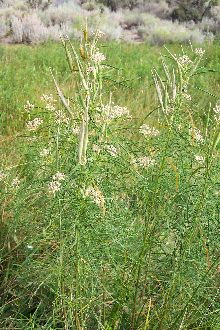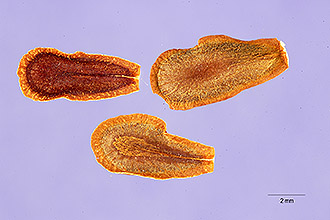Asclepias mexicana auct. non Cav.
Scientific Name: Asclepias mexicana auct. non Cav.

| General Information | |
|---|---|
| Usda Symbol | ASME11 |
| Group | Dicot |
| Life Cycle | Perennial |
| Growth Habits | Forb/herb |
| Native Locations | ASME11 |
Plant Guide
Uses
Warning: Milkweed may be toxic when taken internally, without sufficient preparation, Ethnobotanic: People have used milkweed for fiber, food, and medicine all over the United States and southern Canada, Fibers from the stems of milkweed have been identified in prehistoric textiles in the Pueblo region, Tewa-speaking people of the Rio Grande still make string and rope from these fibers, Zuni people utilize the silky seed fibers, which are spun on a hand-held wooden spindle, made into yarn, and woven into fabric (especially for dancers), Pueblo people eat green milkweed pods and uncooked roots from one of the species that forms fleshy tubers underground, Milkweeds supply tough fibers for making cords and ropes, and for weaving a coarse cloth, Milkweeds stems are collected after the stalks dry in late fall to early winter, The dried stalks are split open to release the fibers, Milkweed fibers are sometimes mixed with fibers of Indian hemp, Apocynum cannabinum, Alfred Brousseau © Brother Eric Vogel, St, Mary's College @ CalPhotos The Yokia Indians of Mendocino County, California, ate the young blossoms of Asclepias fascicularis raw but not in large amounts (Balls 1962), The most common use for these plants, recorded among almost all the tribes throughout California, was to obtain a kind of chewing gum from the sap of Asclepias fascicularis and other milkweed species, The sticky white sap was heated slightly until it became solid, then added to salmon fat or deer grease, Use soil moisture sensors to measure the soil moisture of Asclepias mexicana auct. non Cav.., Wildlife: Milkweed species are attractive to butterflies, bees, and other insects, Accordingly, this is a wonderful horticultural plant for beautiful floral landscaping that attracts butterflies (particularly Monarchs) and other insects, Monarch butterflies are specific to milkweed plants, This is the only type of plant on which the eggs are laid and the larvae will feed and mature into a chrysalis, Eggs are laid on the underside of young healthy leaves, It is important to have large clumps of milkweeds for the young caterpillars; their response to predation is to drop to the ground and "play possum," They cannot find their way back to the milkweed stems, which they need to survive, unless they are fairly densely spaced, Monarch, Queen and Viceroy butterflies are Müllerian mimics; all are toxic, and have co-evolved similar warning patterns to avoid predation, Other insects, which utilize milkweed, are the large milkweed bug, common milkweed bug, red milkweed beetle, blue milkweed beetle, and bees, Toxicity: Milkweed sap contains a lethal brew of cardenolides (heart poison), which produces vomiting in low doses and death in higher doses, Chemicals from the milkweed plant make the monarch caterpillar's flesh distasteful to most animals, At one time, milkweed was classified as a noxious weed due to reported toxic effects on livestock, and efforts were made to eradicate it, Milkweeds are thought to be poisonous to cows and sheep,
Status
Please consult the PLANTS Web site and your State Department of Natural Resources for this plant’s current status and wetland indicator values.
Description
General: Milkweed Family (Asclepiadaceae). Asclepias flowers look like crowns, with the corolla reflexed and hoods elevated above the corolla. In narrow-leaf milkweed, the corolla is reflexed, greenish white, sometimes tinged purple. The hoods are also greenish white. The horns are longer than the hoods. Narrow-leaf milkweed is a glabrous perennial with glabrous to ascending stems. Leaves are in whorls of 3-5, often with axillary clusters of small leaves. The leaf blades are narrowly lanceolate with a tapered base.
Distribution
For current distribution, please consult the Plant Profile page for this species on the PLANTS Web site. Milkweed grows in clumps beside roadways and on abandoned farmlands and other open areas, reaching heights of 120 to 150 cm (4 to 5 ft) during the summer. Milkweed species grow throughout the United States. Narrow-leaf milkweed occurs on dry ground and sunny spots in valleys and foothills at elevations from 50 to 220 m. The range extends through California to Washington, Utah and Baja California.
Establishment
Seed Collection: Collect seeds after pods have ripened, but before they have split open. The seeds are wind dispersed, so be careful when gathering to place in a paper or burlap bag to avoid losing them. Seeds can be directly sewn into the ground in the fall. The seed is very viable. Planting seed the first fall after collecting seeds maximizes revegetation success. It is not certain how long you can store the seeds. Cold treatment for three months improves seed germination in some milkweed species from higher elevations or colder climates (where it freezes in the winter). Revegetation success with milkweed seems to be improved by planting seeds directly in the ground. High mortality seems to occur with plants in pots; Asclepias species don't over-winter well in pots. Once young plants are potted, they often don't re-emerge in the spring. Milkweed plants naturally die back in winter. If you plant them in a pot, they don't come back the next year. If you plant in the ground, they do. Whole Plant Collection: For milkweed species with rhizomes, propagation by cuttings of the tuberous rhizome is also easy and reliable. The cuttings should be made when the plant is dormant. Each piece of the rhizome should have at least one bud (they are about two inches apart). Timing of propagation is important. Harvest or divide plants and move them in October at the beginning of the rainy season. Get the plants in the ground by late fall so they can develop enough root growth to survive the winter. Irrigation the first year will improve survival, and by the second year the root system should be well enough established so plants will survive on their own. Both seedlings and cuttings will usually bloom in their second year, although cuttings will occasionally bloom during their first year (Kindscher 1992).
Management
When used for fiber, milkweed is collected in the autumn after the leaves have begun to senesce or dry up. Plants generally grow in places that have been disturbed, such as road grading and construction sites, logging landing fills, etc. Pete Bunting (pers. comm. 2-9-1999) says, "In the fall when the milkweed has dried, I check to see if they will break off at the ground line. The plants are usually a yellow tan to gray depending on how long they have dried. I like the gray for softer string but the fibers are shorter. The tan stalks have longer fibers but are also stiff and hard to work but very long. I break off many of the plants as I can gather as they are going to re-sprout in the spring. I try and let them dry some more. Then I process them. I have used plants that have over-wintered under snow and they were fine but had soft, short fiber. After 2 winters they are usually no good but you have another year's stalks to pick by then." The dried stalks are then split open and the fibers are twisted into string. Vast quantities of fiber plants are required for the making of nets, regalia, and cordage by California Indians. Blackburn and Anderson (1993) quote Craig Bates of the Yosemite Museum that it takes approximately five stalks of milkweed or Indian hemp to manufacture one foot of cordage. A Sierra Miwok feather skirt or cape contain about 100 feet of cordage made from approximately 500 plant stalks, while a deer net 40 feet in length (Barrett and Gifford 1933:178) contained some 7,000 feet of cordage, which would have required the harvesting of 35,000 plant stalks. Both milkweed and dogbane were burned in the fall by California Indian tribes to eliminate dead stalks and stimulate new growth. Burning causes new growth to have taller, straighter stems (with longer fibers). It also stimulates flower and seed production. Cultivars, Improved and Selected Materials (and area of origin) Seeds and plants of selected Asclepias cultivars are available from many nurseries. It is best to plant species from your local area, adapted to the specific site conditions where the plants are to be grown.
References
Balls, E. K. 1962. Early uses of California plants. University of California Press. 102 pp. Blackburn, T. C. & K. Anderson 1993. Before the wilderness. Environmental management by Native Californians. A Ballena Press Publication. 476 pp. Bouton, D. W. 1995. The Monarch butterfly. A fragile tissue in the wind. Continuum Publishers. Harpersville, New York. Bunting, Pete. Pers comm 2-8-1999. Forester and member of the Sierra Native American Tribal Council. Cooke, S. S. 1997. A field guide to the common wetland plants of western Washington and northwestern Oregon. Seattle Audubon Society and Washington Native Plant Society. 414 pp. Dunmire, W. W. & G. D. Tierney 1995. Wild plants of the Pueblo province. Exploring Ancient and Enduring Uses Museum of Mexico Press. Santa Fe, New Mexico. 289 pp. Dunmire, W. W. & G. D. Tierney 1997. Wild plants and native peoples of the Four Corners. Museum of New Mexico Press. 312 pp. Gilmore, M. R. 1977. Uses of plants by the Indians of the Missouri River region. University of Nebraska Press. 125 pp. Gunther, E. 1945 rev. 1973. Ethnobotany of western Washington. University of Washington Publications in Anthropology, 10(1). University of Washington Press, Seattle, Washington. Hedrick, U.P. 1972. Sturtevant's edible plants of the world. Dover Publications, Inc. New York. 686 pp. Hickman, J. C. 1993. The Jepson manual. Higher plants of California. University of California Press. 1399 pp. Kindscher, K. 1992. Medicinal wild plants of the prairie. An ethnobotanical guide. University Press of Kansas. 340 pp. Kuhnlein, H. V. & N. J. Turner. 1991. Traditional plant foods of Canadian indigenous peoples. Nutrition, botany and use. Gordon and Breach Science Publishers. 633 pp. Martin, A. C., H. S. Zim, &A. L. Nelson 1951. American wildlife and plants: A guide to wildlife food habits. Dover Publications, Inc., New York, New York. 500 pp. Mason, H. L. 1957. A flora of the marshes of California. University of California Press. Berkeley and Los Angeles, California. 878 pp. Moser, C. L. 1993. Native American basketry of Southern California. Riverside Museum Press. 155 pp. Powell, J.A. & C.L. Hogue 1979. California insects. University of California Press. 388 pp. Schmidt, M. G. 1980. Growing California native plants. University of California Press. 366 pp. Stewart, B. 1997. Common butterflies of California. West Coast Lady Press. 255 pp.

